Look again through your decolonised lens
Has the Vibe Shift come to art galleries and museums?
‘Museum fatigue’ is said to be a state of mental exhaustion caused by information overload, one that afflicts visitors to exhibitions. I started to suffer my own particular version of it in 2022 after visiting the Hogarth exhibition at the Tate, where I was slightly puzzled by the gallery notes. They looked like they had been written by the staff of Teen Vogue magazine, featuring bizarrely irrelevant monologues about immigration and racism, and filled with the terminology of the Young Scold Left.
It turned out that this style was now widespread, and since then, I’ve collected a number of these museum and art gallery notes for my own special ‘exhibition’, presented here.
Hogarth’s The Tête à Tête part of a series called Marriage A-la-Mode, which satirises 18th century society and points to the downsides of marrying for status, featured the following caption:
‘Dissolute White people correspond with shiny white objects in this scene of domestic disarray…. In his pocket, the booklet “Regeneration” references a sermon by the Methodist evangelist George Whitefield, who preached moral purity in North America and Britain while helping legalise slavery in colonial Georgia in 1751. However indirectly, in this painting the atrocities of Atlantic investments are invoked in relation to the outsized expenditure on Asian luxury gods – overall, a picture of White degeneracy.’
By The Artist Painting the Comic Muse, we were informed that ‘The curvaceous chair literally supports him and exemplifies his view on beauty. The chair is made from timbers shipped from the colonies, via routes which also shipped enslaved people. Could the chair also stand-in for all those unnamed Black and Brown people enabling the society that supports his vigorous creativity?’
Most bizarre of all was the note by The Toilette, which featured a bizarre first-person narrative:
‘My name is Oumar and I am a butler-cum-manservant from Mali. However, my main function is to make this unimportant aristocratic household look exceptionally wealthy. The Countess treats me with disdain almost all of the time, but she loves the way I can be a delightful African Gentleman when she needs me to take that role. To her I am simply a Black body rippling with exotic otherness. My adorable little compatriot, who is pretending to sit quietly, is actually the cleverest person in this room. We work together and spend an inordinate amount of time laughing. We know however, that this family is doomed, ruined by boredom and greed. But we will fall before they do and we can never hope to recover.’
There were also various detours about diversity in London, Amsterdam and Paris, most of which were largely irrelevant to the paintings, but the running theme of the exhibition was the running theme of the Great Awokening: white racial sin and the unpayable debt owed for the crime of slavery. Hogarth was even tarnished by the fact that slave-owners bought his paintings.
The year 2022 was the thick of the Peak Woke period which began on May 25, 2020, although it’s debatable whether Britain has passed out of it; even while the ruling class await helplessly the country’s takeover by the populist Right, organs of the state continue to push racial discrimination. The same rituals are still played out throughout the year, now far more pronounced among late-adopter provincials. Britain’s institutions, emptied of conservatives, continue to divert from their original purpose and push politicisation in every sphere. But 2022 was bad.
That year I wrote about the Wellcome Collection as an example of an organisation which has been captured by ideologues at odds with its original remit. The Wellcome Trust had spent £1m on implicit bias training, a process largely considered to be useless, proclaimed itself to be institutionally racist, and denounced its own founder, declaring that ‘Henry Wellcome’s collection was a vast personal project, the privilege of a wealthy white man in the Victorian era.’
That year the Wellcome Collection featured a new caption beside a fragment of Jeremy Bentham’s skin, stating: ‘Bentham died while contesting the immediate emancipation of enslaved people.
‘Written on the skin is a reference to him bequeathing his body for dissection. The 84-year-old’s fantasy was that “every man might be his own statue” and the 1832 Anatomy Act ushered in the new scientific era or “race” science. Decentre Bentham. Decentre Henry Wellcome’s Bentham.
‘After emancipation how could supremacy be justified? Through culture; museums recentered the white cis-male body. Written on the skin is whiteness. “Bought at Stevens Auction Rooms in 1925.”
‘Times up. Just rewriting labels isn’t enough. Let’s face up to all the human remains that Henry Wellcome collected. Dismantle Wellcome’s enduring colonialism, its white infrastructure.’
The man behind the curation had, just a year or so earlier, accused the Tories of ‘trying to ignite a fake “culture war” in the arts, museums and heritage sector.’ Remember, they’re fighting a culture war; we’re just dismantling enduring colonialism and white infrastructure.
Bentham, incidentally, supported the abolition of slavery, for all the thanks he got.
In 2022 the Courtauld Gallery added new labels to some of its paintings on display, warnings viewers about misogyny and sexism. In 2024 the Fitzwilliam Museum in Cambridge ‘reordered into themed categories, in an “inclusive” shake-up, with artwork grouped into categories including Men Looking at Women, Identity, Migration and Movement.’ It warned that Constable’s bucolic scenes had a ‘darker side’ and could evoke ‘nationalist feeling.’ The wrong kind of ethno-narcissism, as opposed to the good kind.
The Burrell Collection in Glasgow used early modern figures to make the argument that ‘trans rights are human rights’, and a 10th century Buddhist icon to invite visitors to reflect on how trans people feel.
I think if we lived in a parallel universe, and a gallery used an exhibition of 17th century Dutch masters to lecture on the necessary for economic liberalisation and the evils of socialism – a more relevant interpretation – people would feel that the museum curators might not entirely be fulfilling their function of promoting culture.
Many notes, especially those featuring religious themes, are often filled with errors. Much of it is inane. But at every opportunity icons of the old religion are repurposed to serve the new, figures of Christianity rebranded as ‘virtuous pagans’ of social justice.
So, similarly, St Francis of Assisi was proclaimed as an LGBT ally by the National Gallery.
The Kelvingrove Art Gallery and Museum in Glasgow, meanwhile, added ‘interpretation labels’ about colonial history in 2022, framed in red to suggest danger.
The British Museum’s Stonehenge exhibition fell for the temptation of applying 21st century concepts about gender to the 21st century BC. I have no idea what people at the time believed - none of us do - but I strongly suspect that the Neolithic Farmers of ancient Britain did not have had any conception of ‘gender neutral’, anymore than Viking women buried with their husband’s swords were actually trans. It seems like an obvious case of applying modern political beliefs to vastly alien cultures, a failure of anthropology and a failure of imagination.
In 2021 the National Maritime Museum took to apologising for the lack of Black voices, as well as collaborating with the then fashionable charity Mermaids (not so fashionable now).
An obsession with ‘enslaved people’ is a theme that runs through all gallery notes, as illustrated here at the Dulwich Picture Gallery: Sit your white ass down and look again through your decolonised lens.
The same trend is found in Australian museums, similarly colonised by American academia, which naturally carry land acknowledgements.
In contrast, I’m told that museums in former British colonies in Africa mention colonialism in a purely detached way, without any of this moralising language.
What explains this politicisation? I don’t think it’s a matter of public demand; gallery and museum visitors tend to be older, although younger attendees are certainly more likely to be more socially liberal than average. I imagine that it’s off-putting to many, and attractive to rather few.
Mostly it must be downstream of educational trends, and a look through the Hogarth programme shows it heavily dominated by academics interested in progressive themes around race and gender. They cite their fields of expertise as ‘uncovering marginalised and silenced histories, figures, and cultural expressions’; ‘themes of identity, and the inter-relationship between race, power and language’; ‘visual representations of Black emotionality and melancholy’; ‘people, place, and object-based commodification, performing furniture to explore themes of race and gender.’
There is also a ‘lady’s Greek’ element, Elizabeth Barrett Browning’s term for intelligent but not extensively educated members of the middle class acquiring a small amount of that language so as to signal status. Despite the name, it wasn’t exclusively female: Mr Thornton in North and South learns some ancient Greek in the evening because those ‘mysterious sentences’ added some degree of refinement. Academic jargon offers the same purpose, signalling a level of education and therefore status, without the difficulty of actually reading Homer. (Judith Butler’s prose may be as unintelligible as ancient Greek, but no expects you to show an understanding of it.)
But there is also a concerted effort to make every space political. The Museums Associations recently published a statement on ‘why it’s important for the new code to have an ethical commitment to anti-racism.’
Its artistic director stated that: ‘Museums are neither neutral nor disconnected from the imperialist Enlightenment narratives upon which many of them were founded… No longer are museums seen as value free or having a monopoly on knowledge, but are increasingly demanded to be spaces of social justice and debate. They are increasingly seen as institutions where the assumed supremacy of Western knowledge can be challenged alongside indigenous and marginal epistemologies.’
Anti-racism is not a neutral term merely suggesting a distaste for racial prejudice; it has a specific progressive meaning that implies support for equality of outcomes (except where whites are disadvantaged), as well as raising the status of some racial groups over others. It is also not a belief system that invites ‘debate’. When institutions use the term, they are signalling that they are overtly politicised, not a healthy state of affairs for civil society.
The same thing strikes me about politicised art as it does about history as morality tale: are its proponents in love with their subject? Do they have a passion for art of antiquities, with all its human frailties as well as triumphs, or a passion for politics, the end goal of which is overcoming that human condition? The latter, in my experience, tends to consume the former.
There is some speculation in the American art world that things are changing and that ‘a faith in a certain type of cultural politics has fallen apart.’ I don’t know if that’s true, but it’s notable that the National Gallery has chosen to buck the trend, refusing to add political messages and instead celebrating ‘the great figures of the canon.’
Sir Gabriele Finaldi, the Gallery director, told The Daily Telegraph in May: ‘Fundamentally, it is a celebration of the collection, of painters, and of the great European tradition. We think of it as an aesthetic experience, which then can become an educational experience, and a social experience. Not necessarily a political experience.’ Indeed, I think we’ve had enough ‘political experiences’ in art galleries, enough to fill many of us with a certain fatigue.
I think I’ve got permission from everyone who took the photographs, but if I haven’t, please get in touch.



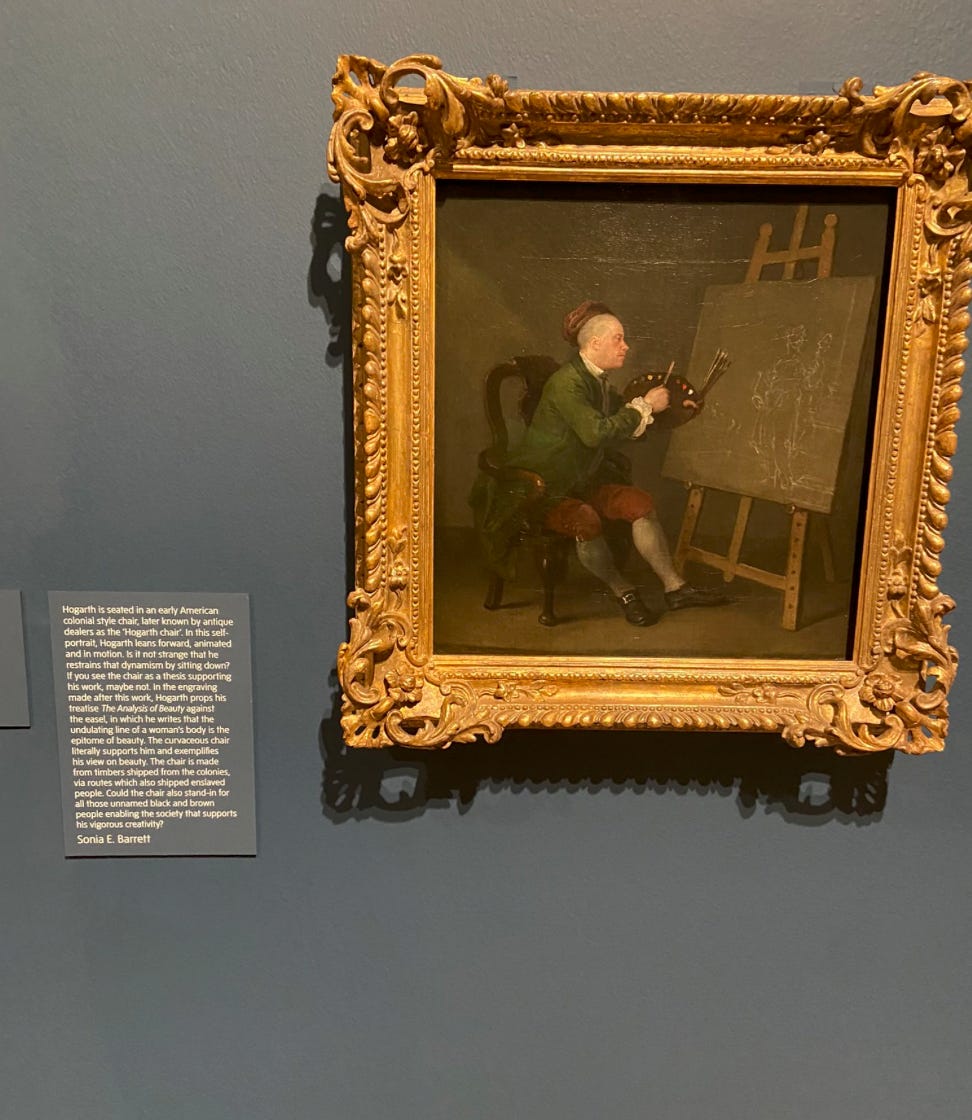
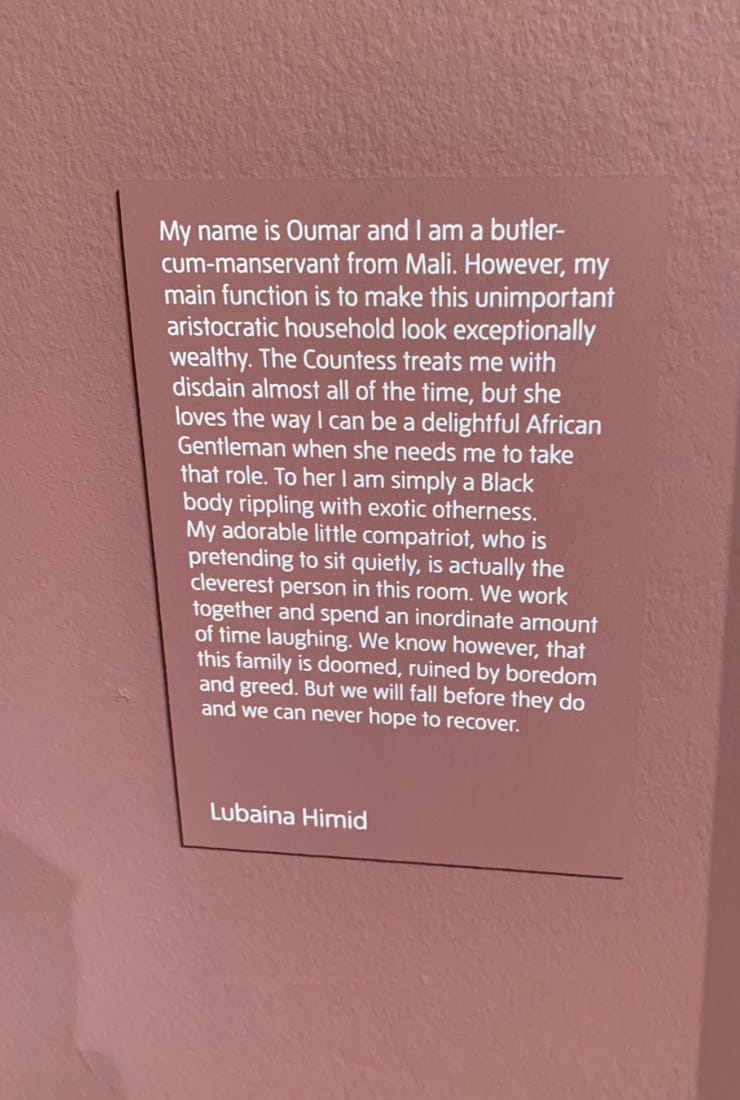
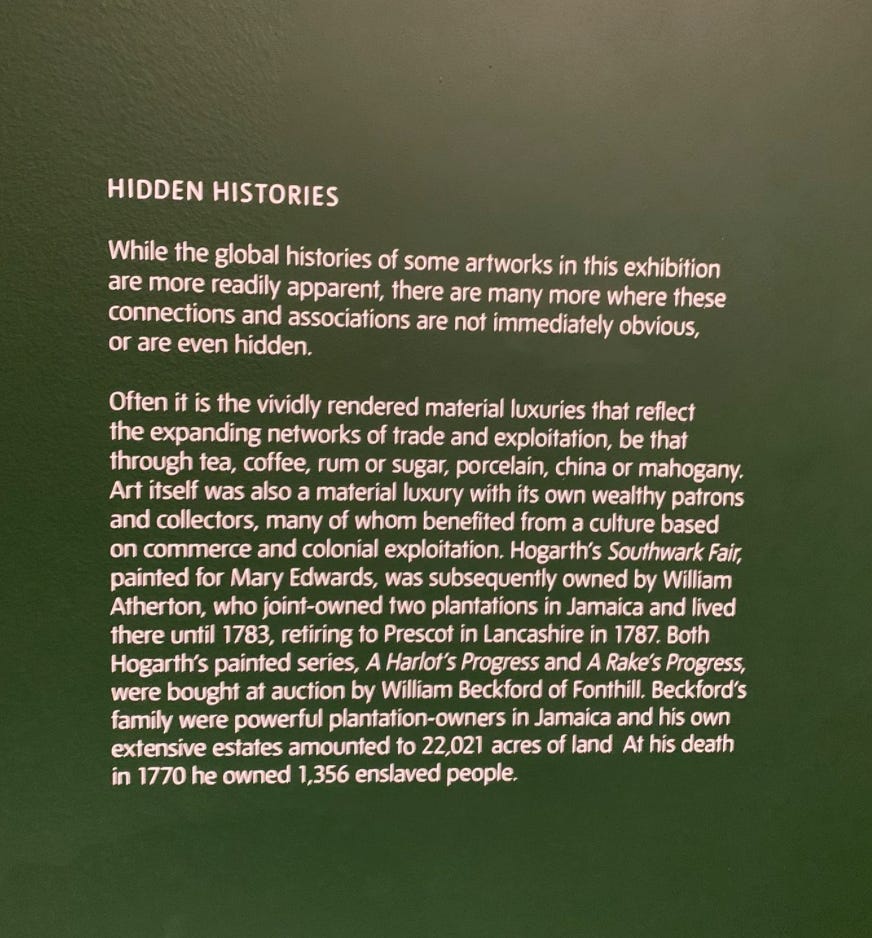
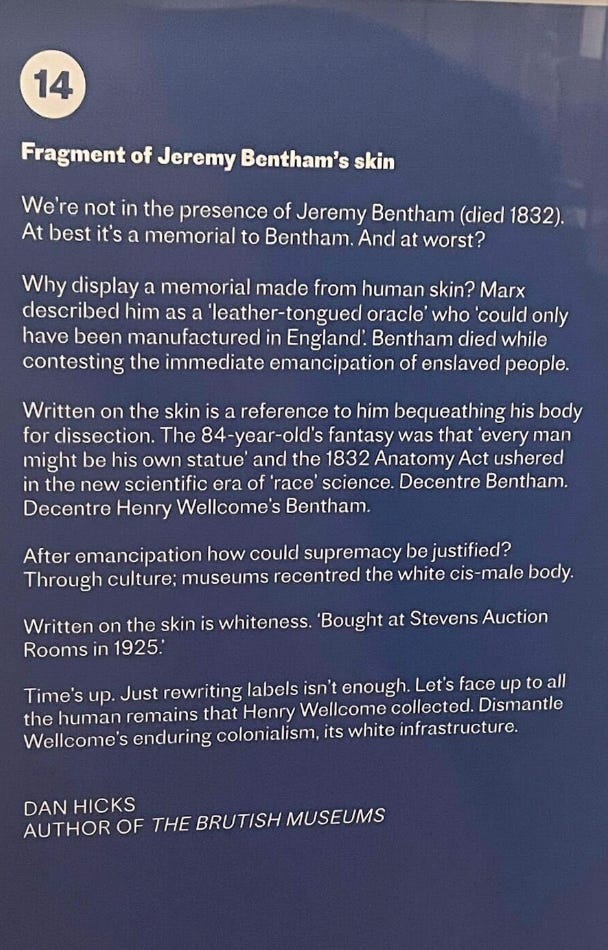
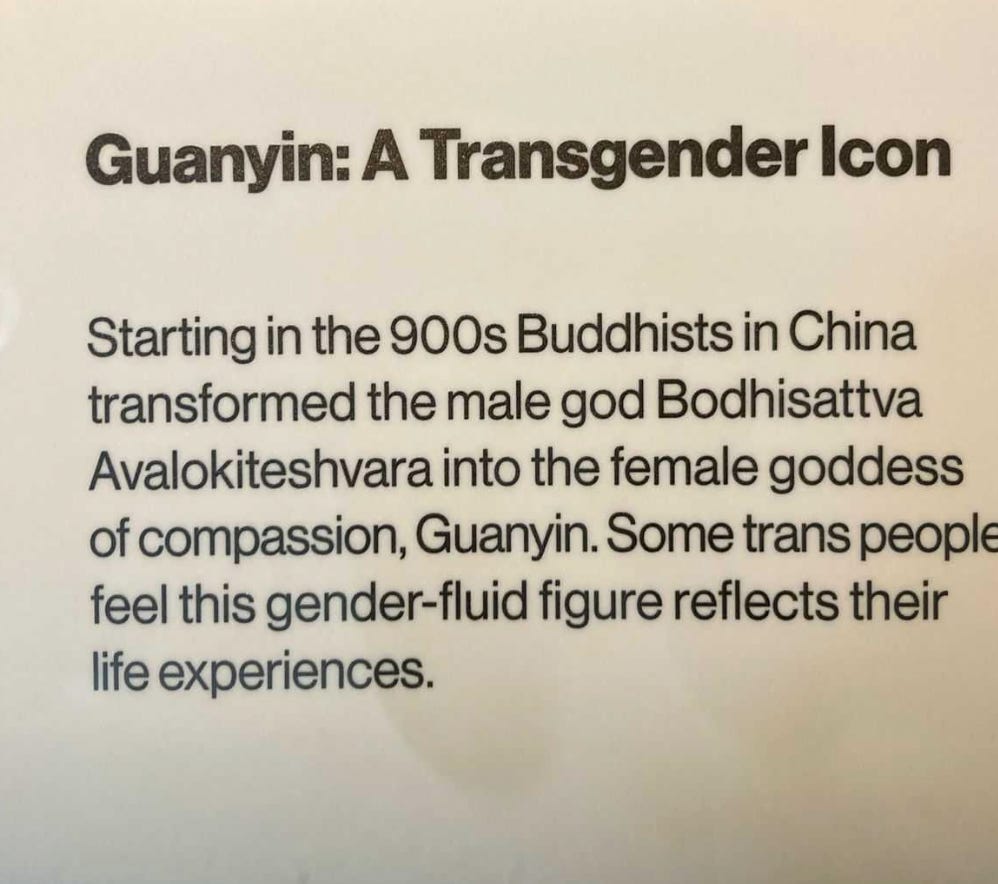
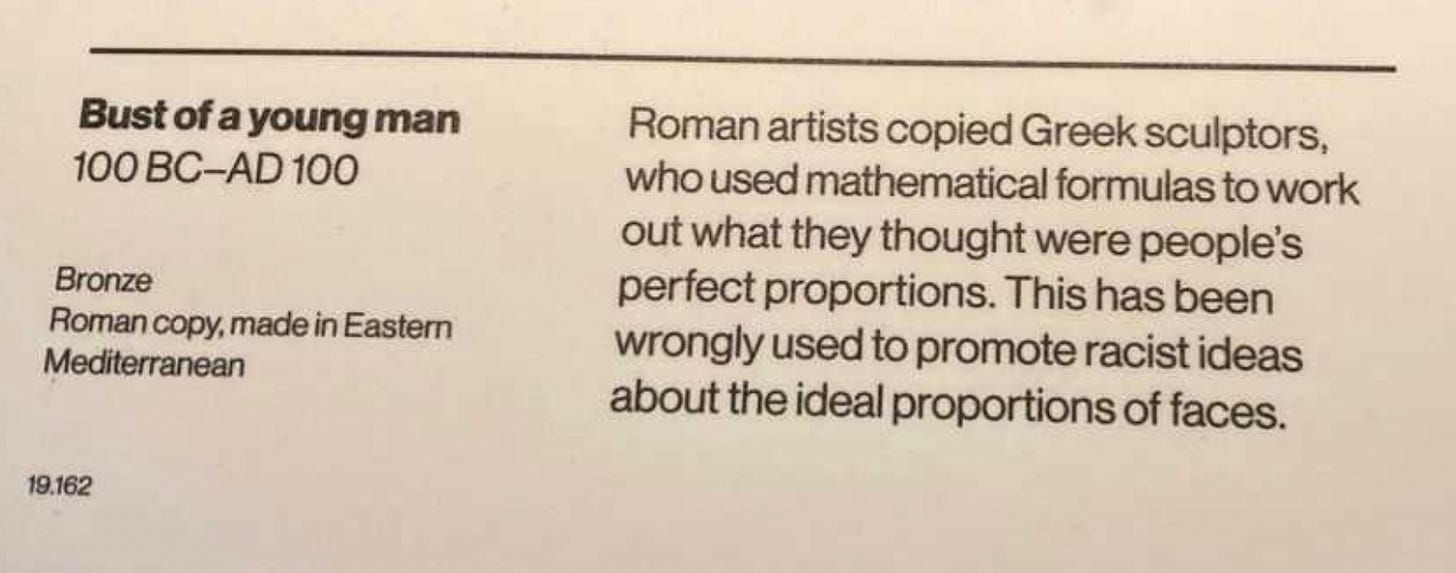




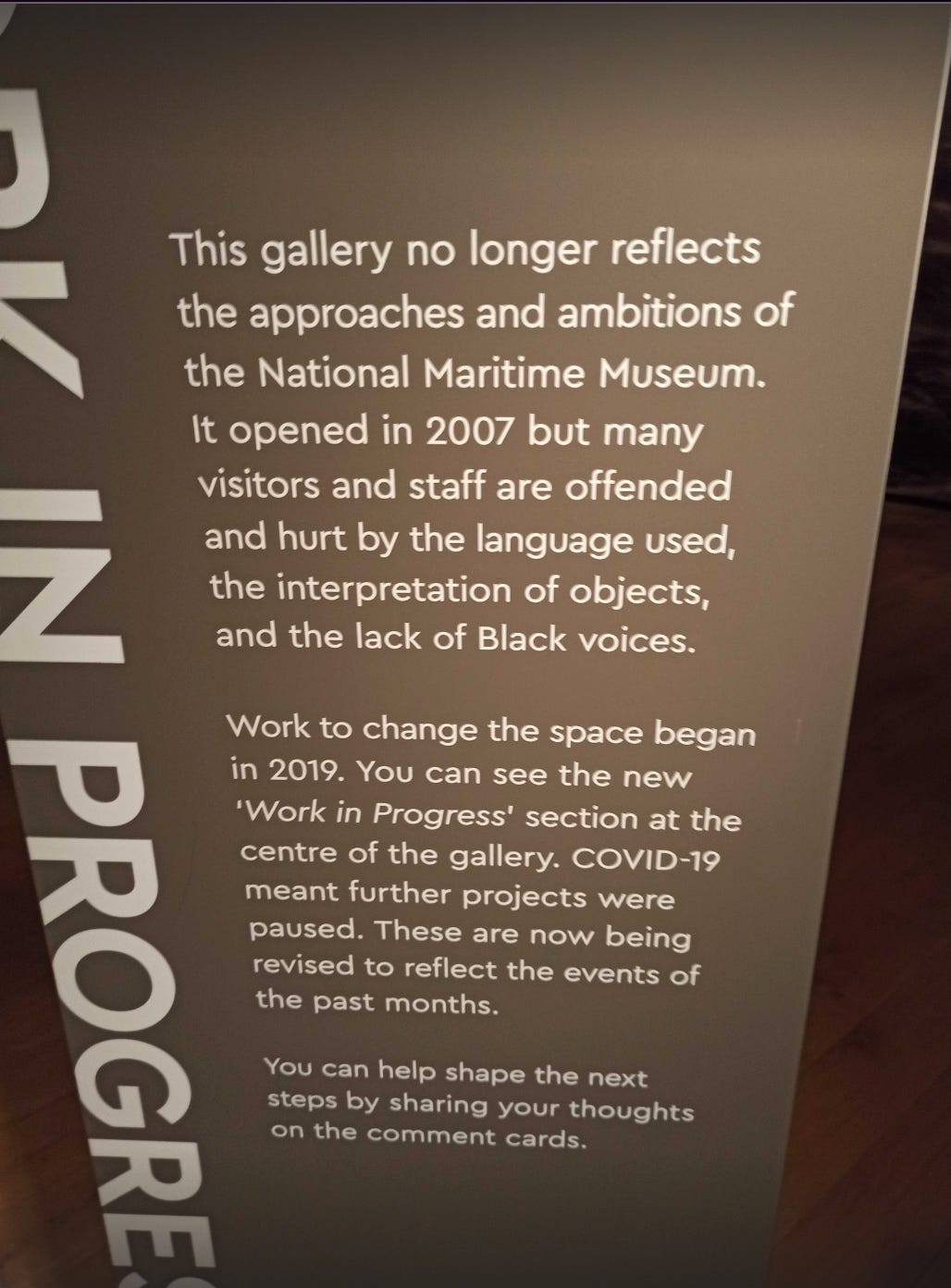




“To her I am simply a Black body rippling with exotic otherness” as with all lib kitsch, this stuff is writhing with a barely repressed quasi-sexual desire to revel in being downtrodden, restrained, dominated etc. It’s so gross and inappropriate for a public space
The man behind the labels in the Wellcome Trust exhibition is also in charge of the Pitt Rivers museum in Oxford, which is pretty much the platonic ideal of the Victorian gentleman-collector’s cabinet of curiosities and, I believe, has very strict provisions regarding any alterations to the way things are displayed.
I cannot begin to fathom why somebody who clearly detests it and all it stands for would want to occupy that role.